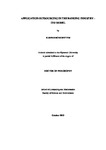APPLICATION OUTSOURCING IN THE BANKING INDUSTRY – ITO MODEL
| dc.contributor.supervisor | Wentzel, Christoph Dr. | |
| dc.contributor.author | Kronawitter, Karin | |
| dc.contributor.other | School of Engineering, Computing and Mathematics | en_US |
| dc.date.accessioned | 2014-04-29T14:09:43Z | |
| dc.date.available | 2014-04-29T14:09:43Z | |
| dc.date.issued | 2014 | |
| dc.date.issued | 2014 | |
| dc.identifier | 10180578 | en_US |
| dc.identifier.uri | http://hdl.handle.net/10026.1/2989 | |
| dc.description.abstract |
Information Technology Outsourcing (ITO) in terms of the replacement of the in-house production of IT activities by the use of third party suppliers had already started in the 1960s and has increased considerably. For 2013, the Gartner Group expected that the global ITO market would reach a volume of 288 bn US dollars. Until 2017, the market should grow on average about 5.4% yearly. Despite the rich set of experiences companies have already had with ITO, the chances of success are seen as at best 50:50. Currently, the dramatic growth of ITO is accompanied by backsourcing of formerly outsourced IT functions or reports about dissatisfaction and problems with ITO. Scientists put ITO failures or problems down to a lack of modelling of all the possible factors affecting ITO success and demand a specific ITO theory as a basis for better explaining and predicting successes and failures in an IT sourcing context. This thesis takes up this research gap. The aim of this thesis is to develop a novel ITO Model which aids organisations in planning and implementing ITO solutions by guiding them through the ITO process steps of preparation, selection, contract, transition, execution, and post-deal comprising a comprehensive picture of the weighted aspects relevant to ITO success and their interdependencies. In order to achieve this aim, the following objectives were established for this thesis: raising the topical level of scientific knowledge of the last decades about successinfluencing factors in the ITO field based on an extensive literature survey of 48 scientific articles deriving ITO success factors from empirical research work; structuring of this success factor knowledge by the development of two ITO taxonomies (taxonomy of success factors and taxonomy of success factor interdependencies); testing its practical applicability on the basis of 8 real long-running application outsourcing cases in the banking industry; further development of the success factor knowledge by identification of weightings and the temporal relevance of relevant success factors / success factor interdependencies within the ITO process. Design of the novel ITO Model based on the empirical knowledge gained by development of rules for relevant success factors and success factor interdependencies, by arrangement of these rules in temporal order within the ITO process and by assignment of these rules to four levels of environment. | en_US |
| dc.language.iso | en | en_US |
| dc.publisher | Plymouth University | en_US |
| dc.subject | Long-term Outcomes | |
| dc.subject | Success Factors | |
| dc.subject | ITO Model | |
| dc.subject | IT Application Outsourcing | en_US |
| dc.title | APPLICATION OUTSOURCING IN THE BANKING INDUSTRY – ITO MODEL | en_US |
| dc.type | Thesis | |
| plymouth.version | Full version | en_US |
| dc.identifier.doi | http://dx.doi.org/10.24382/1511 |
Files in this item
This item appears in the following Collection(s)
-
01 Research Theses Main Collection
Research Theses Main


